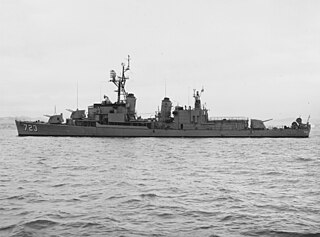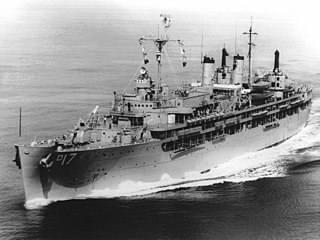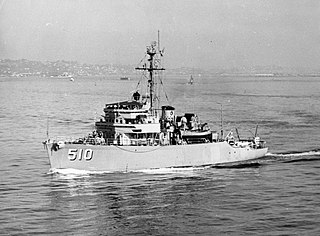
USS Arnold J. Isbell (DD-869), a Gearing-class destroyer, was the only ship of the United States Navy to be named for Arnold J. Isbell, an aircraft carrier captain during World War II. The ship was laid down on 14 March 1945 at Staten Island, New York, by Bethlehem Mariners Harbor, launched on 6 August 1945 and commissioned on 5 January 1946. Constructed too late to see action in World War II, the vessel initially served as a training ship with the United States Atlantic Fleet, before transferring to the Pacific and deploying to Korea during the Korean War and off the Vietnam coast during the Vietnam War. In 1972 Arnold J. Isbell was made part of the reserve training fleet and in 1974, sold to Greece where the ship was renamed Satchouris and served with the Hellenic Navy until being sold for scrap in 2002.

USS Brinkley Bass (DD-887) was a Gearing-class destroyer in service with the United States Navy from 1945 to 1973. She was then transferred to Brazil where she served as Mariz e Barros (D-26) until 1997. The destroyer was finally sunk as a target in 2000.

Acadia (AD-42) was a Yellowstone-class destroyer tender in the service of the United States Navy, named after Acadia National Park. She was inactive and in reserve after her 1994 decommissioning at Naval Inactive Ship Maintenance Facility (NISMF), Pearl Harbor, Hawaii, under maintenance category B, until sunk off Guam during a live-fire training exercise on 20 September 2010. She was the first ship to house a wartime mixed-sex crew and was unofficially nicknamed "The Love Boat" in the 1991 Persian Gulf War after 36 women became pregnant during deployment.

USS Blackfin (SS-322), a Balao-class submarine in commission from 1944 to 1948 and from 1951 to 1972, was a ship of the United States Navy named for the blackfin cisco, a food fish of the Great Lakes.

USS Ajax (AR-6), in service 1943 to 1986, was the second Vulcan-class repair ship and the fourth ship in the United States Navy to bear the name. Laid down in 1941, launched in 1942 and commissioned in 1943, she was decommissioned in 1986 and finally sold for scrap. Ajax received four battle stars for Korean War service and five campaign stars for service in Vietnam.

USS Walke (DD-723), an Allen M. Sumner-class destroyer, was the third ship of the United States Navy to be named for Henry A. Walke, a Rear Admiral during the Mexican–American War and the American Civil War. The third Walke (DD-723) was laid down on 7 June 1943 at Bath, Maine, by the Bath Iron Works and launched on 27 October 1943; sponsored by Mrs. Douglas Dillon. The ship was commissioned at the Boston Navy Yard on 21 January 1944.

USS Alfred A. Cunningham (DD-752), an Allen M. Sumner-class destroyer, is the only ship of the United States Navy to be named for Alfred Austell Cunningham, a USMC officer and aviator.

USS Walton (DE-361) was a John C. Butler-class destroyer escort in the United States Navy. It was named after Merrit Cecil Walton, a Marine Corps platoon sergeant with the U.S. 1st Marine Division, who died on Gavutu during the Battle of Guadalcanal and was posthumously awarded the Navy Cross for "extraordinary heroism".

USS Surfbird (AM-383) was an Auk-class minesweeper built during World War II for the United States Navy. She was the only U.S. Navy ship named for the surfbird.

USS Frontier (AD-25) was one of four Klondike class destroyer tenders built at the tail end of World War II for the United States Navy.

USS Benner (DD/DDR-807) was a Gearing-class destroyer of the United States Navy, named for Marine Second Lieutenant Stanley G. Benner (1916–1942), who was killed during the Battle of Guadalcanal.

USS Carpenter (DD/DDK/DDE-825) was a Gearing-class destroyer of the United States Navy, named for Lieutenant Commander Donald M. Carpenter (1894–1940).

USS Klondike (AD-22/AR-22) was a destroyer tender in service the United States Navy from 1945 to 1970. In 1960, she was redesignated as a repair ship. After spending another five years in reserve, she was sold for scrap in 1975.

The fourth USS Worden (DLG/CG-18), a Leahy-class cruiser, was a ship of the United States Navy named in honor of Admiral John L. Worden. Originally called a "destroyer leader" or frigate, in 1975 she was redesignated a cruiser in the Navy's ship reclassification. The ship entered service in 1963 and participated in the Vietnam War.

USS Piedmont (AD–17) was a Dixie-class destroyer tender built during World War II for the United States Navy. Her task was to service destroyers in, or near, battle areas and to keep them fit for duty. She served in the Pacific Ocean during World War II, the Cold War, the Korean War, and the Vietnam War. For her work in battle areas, the ship was awarded four battle stars for her Korean War efforts and one for Vietnam War service.

USS Jason (AR-8) was the fourth of the Vulcan class repair ship of the United States Navy in service from 1944 to 1995, serving in World War II, Korea, Vietnam, and the Gulf War. At the time of her decommissioning, Jason was the oldest ship in continual commission in the United States Navy, and the final ship in continual commission from World War II onward.

USS Ashtabula (AO-51) was a Cimarron-class fleet oiler of the United States Navy in service from 1943 to 1991. She survived three wars and was awarded eight battle stars for World War II service, four battle stars for Korean War service, and eight campaign stars for Vietnam War service. In the mid-1960s Ashtabula became the lead ship of her class, when she and seven other Cimarron-class oilers were lengthened ("jumboized"). She has been the only U.S. Navy ship to bear the name Ashtabula, after the City of Ashtabula which was named after the Ashtabula River in northeast Ohio.

USS Advance (AM-510/MSO-510) was an Acme-class minesweeper acquired by the U.S. Navy for the task of removing mines that had been placed in the water to prevent the safe passage of ships.

USS Wexford County (LST-1168), previously USS LST-1168, was a United States Navy landing ship tank (LST) in commission from 1953 to 1971, which saw service in the Atlantic, Caribbean, and Pacific and served in the Vietnam War..

USS Apache (AT-67/ATF-67) was a Navajo-class fleet tug, later fleet ocean tug, in commission in the United States Navy from 1942 to 1946 and from 1951 to 1974. She saw service in World War II, the Korean War, and the Vietnam War.




















